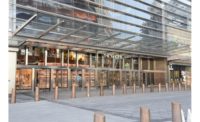Hillary Hulteen exudes empathy, sounding more like a motivational speaker than a construction executive as she talks about values, human beings and spirituality—not your typical industry topics.
The CEO and co-owner of Lafayette Metal & Glass Co., based in Hauppauge, N.Y., has implemented programs based on a “talent management mindset” to grow young workers and retain them for the long haul or to attract seasoned employees from within or outside the construction industry.
Employees who work for Hulteen and co-owner and president Jack Walsh, her husband, use the term “like my friends” to describe their leadership style. She admits it sounds almost too touchy-feely compared with the way other construction-sector firms may be managed. “People kind of made fun of us,” Hulteen says of how she and Walsh have run the fabrication, repair and installation company since buying it in 2011.
But there’s no making fun of their success. The pair has grown Lafayette from a firm that had $1 million in revenue, five full time employees and barely broke even to one that is on track for sales of $48 million in 2018 with a workforce of 97—and counting—that required a move last month to larger offices.
With that enlarged workforce, Lafayette has completed numerous notable interior and exterior building projects that include a $4.6-million portion of the renovation of investment bank Credit Suisse offices at 11 Madison Ave. in Manhattan, completed this month, and the PricewaterhouseCoopers headquarters at 90 Park Ave., with a subcontract worth $2.45 million. Other notable projects in 2017 included Facebook’s office at 233 Park Ave. South, Google’s digs at 111 8th Ave. and the Durst Organization in One World Trade Center. Outside New York and New Jersey, the company has done projects in Boston and Maryland.
Lafayette’s steady rise to No. 20 on ENR New York’s Top Specialty Contractors list is tied to a 59% revenue increase in 2017, to $35 million from $22 million the year before. Its financial growth and innovative management style has led to Lafayette Metal & Glass’ selection as ENR New York’s Specialty Contractor of the Year.
The Long Island-based company has been around since 1899, beginning as a fabricator and installer of glass, mirrors and display cases for retailers in New York City’s Bowery district. Jumping forward 112 years, Hulteen and Walsh decided to buy “a company we could rebrand,” he says, since banks weren’t eager to loan money to start-ups in 2011. They are the firm’s fourth owners, according to Hulteen.
Walsh is a former journeyman glazier with decades of field experience and was a member of IUPAT Local 1087. Hulteen’s construction background involves change management, operations and finance. That colors how she’s approached the challenge of growing and transforming Lafayette.
“I thought it was a great chance to professionalize the industry,” says the CEO, whose past roles include director of operations for Posillico Group and senior consultant to the NYC School Construction Authority.
According to Hulteen: “A lot of owners have huge field backgrounds, but not business backgrounds … a lot understand fabrication, but don’t know management. They didn’t attend strategic conferences.” She says that is why many aren’t able to lead their companies to improve their business methods—or their bottom lines.
“They didn’t have to change … but the trades weren’t growing professionally” at a rate comparable to other industries, the CEO claims.
So the new bosses started pretty much from scratch. And that meant a foundation of “people with the right aptitude,” even if they didn’t have a construction background, Hulteen says. The firm’s office and support staff include employees recruited from mill working companies, which according to Hulteen are similar in operation to “the trades.” One hire who had worked in the homebuilder sector was great fit at Lafayette, she says: “You have to communicate at a high level with residential clients, and they’re very demanding.”
While 70% of its workforce is now younger than 40, Lafayette’s older employees had to learn communications technology to streamline business, says Melissa Di Diego, the contractor’s employee experience architect. Milestone, the firm’s own project management software—what Hulteen calls “Salesforce on steroids”—increases transparency by letting all stakeholders access all relevant project information, but it was a learning curve for both staff and clients, Di Diego and Hulteen say.
Then there’s the firm’s interactive culture. “Some people aren’t used to the collaborative environment here, to interacting with others on a day to day basis,” Di Diego says.
That focus on collaboration extends to the field, says Daniel Cordero, Lafayette’s general superintendent, speaking from one of the company’s latest projects—the site of the new FAO Schwarz store in Manhattan, which opened Nov. 16.
“I have three trades: glaziers, carpenters and ironworkers. I do things a little differently. Everyone works together—a composite crew,” says Cordero, who already worked at Lafayette before the 2011 purchase. He contrasts his jobsites with how other companies hire trades, usually bringing in ironworkers for steel construction first, then the glass installers.
“I keep the crew together, and then they can all learn from each other,” Cordero says. “We all come together as a family, as a team.”
Cordero was the company’s only “field guy” before Hulteen and Walsh took over. He verifies that those were lean times, and that he almost quit out of financial necessity. Since the acquisition, he’s risen from installer to foreman to general foreman to superintendent to his current director role. “I’m very big about growing with the company,” Cordero says. “I have guys who were apprentices with me, and now they’re foremen.”
Cordero, who Walsh now calls “my right hand man,” is just one example of Hulteen’s “talent management mindset” in action. Di Diego says of the firm’s hiring strategy: “We want to find people who want to advance, and then to keep them as long as possible.”
That means linking veteran workers with 30 years of experience to millennials who hope to learn from them and hone their craft. It also means developing managerial professional improvement programs; departmental training to help employees obtain certifications such as OSHA safety training; and creating, for example, a career track from journeyman to foreman.
Brittany Sciuti is one success story at the firm. At age 31, and as the only female journeyman glazier in Local 1087, she’s now a foreman, and has seemingly broken barriers of age and gender in the construction industry.
“I would never have had this opportunity” with her prior company, Sciuti says. She joined Lafayette in March 2017, a day after being laid off. From the get-go, “I would say I was very motivated in wanting to work my way up.” While those who know Sciuti credit her abilities and hard work, she says she’s thankful that “the bosses saw something in me.”
That’s led to an environment in which she was respected as a supervisor by all “the guys,” leading teams of up to 12 subordinates. To firms that want to increase the number of women in their field ranks, “Just give them the opportunity,” Sciuti advises.
“Encouragement from others made me believe in myself,” she adds. This kind of support from supervisors also makes sense from a productivity standpoint since, Sciuti says, “Job security makes you work harder.”
Developing their workforce with advancement opportunities is a necessity for Lafayette, which touts it prominent clients. Hulteen and Walsh say their client list has grown “organically,” employing no sales team but rather relying on word of mouth and existing relationships.
“We started off doing a simple glass door for a couple thousand dollars,” Walsh says. “We are extremely selective. We don’t randomly bid general contractors [that] we don’t have a relationship with. We interview them as much as they interview us.”
The PricewaterhouseCoopers project, for example, happened because the owners of 90 Park Ave. recommended Lafayette to Gilbane Building Co., which was the project’s construction manager. The scope of work included backpainted glass, canopy and storefront, and specialized doors and plastics. “It was the perfect example of our new installation division,” Walsh says.
Lafayette has been increasing the type of services it offers. There’s also a repair and maintenance division that can fix, replace or prevent damage to glass. And starting in 2019, Lafayette will launch a new custom metal fabrication business. Walsh notes that projects are now becoming 50% metal and 50% glass, compared with 90% glass when he and Hulteen took over the firm. General contractors and construction managers prefer to award a single metal and glazing package rather than separate contracts for efficiency and costs purposes, he explains.
“Architectural metal is the largest aspect of our business now,” Hulteen says, surpassing glass and forcing the word “metal” into the firm’s name. The company has already promoted a project manager for the impending factory, which will fabricate metal for elevator lobbies, storefronts and staircases, among other uses.
Clients seem to approve of Lafayette’s services and process. Jason Spector, general superintendent at Holt Construction in New York, says the firms have worked together on projects in various sectors, such as tenant build-outs and improvement projects for developers Vornado and Tishman Speyer, and multimillion-dollar airport lounges for American Airlines, United Airlines and Dubai-based Etihad. The two are currently working on Air Canada’s Maple Leaf Lounge in LaGuardia Airport’s new terminal.
“The owners had a hands-on approach, which was very similar to Holt’s model,” Spector says. He also praises the way Lafayette shortened time frames thanks to “expediting and utilizing multiple sources for material solutions,” its labor force that “has exceeded our expectations” and the firm’s reputation for being “exceptionally adaptive and responsive with submittals, shop drawings and project execution.”
Spector adds: “They have excellent experience in architectural metal and specialized bronze, which has been a great asset when collaborating with projects’ assigned architectural team.”
Despite its strengths, Lafayette isn’t immune to industrywide challenges. With so much construction happening, schedules are getting increasingly tighter, and that particularly affects the metal and glass contractor.
“The biggest obstacle for us is being the last trade out the door,” Walsh says. “There are 10 to 20 trades that go before us, so when they start losing time, we start losing time .… The time you have for error is almost none, so it’s important to be proactive. The minute you’re reactive, you’re dead in the water.”
Being proactive is clearly the name of the game for Lafayette, whether by implementing worker development programs, new lines of business or technology that offers greater transparency to employees and clients alike. But the challenge is to keep on improving in an industry that isn’t always cutting edge. Says Hulteen: “When you’re in an archaic industry, you can’t look at it [for innovation], you have to look beyond.”









Post a comment to this article
Report Abusive Comment